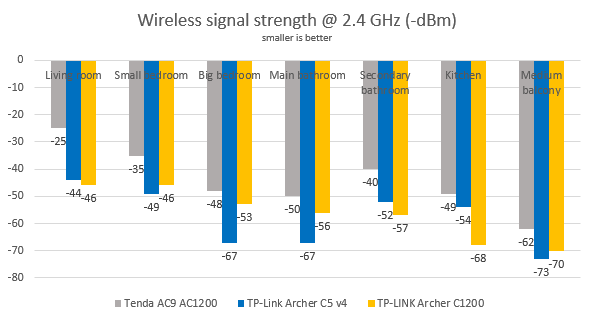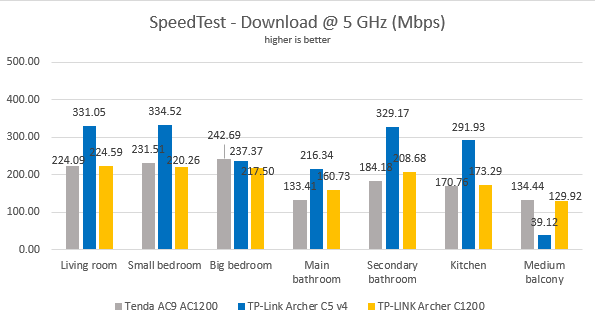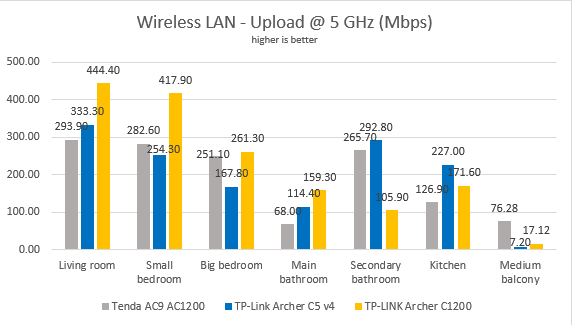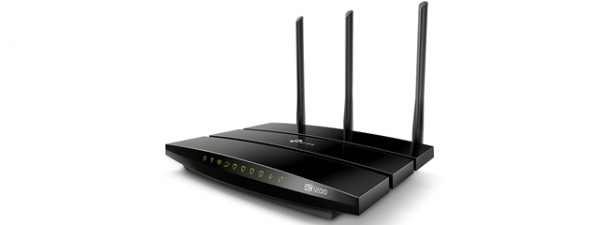
Wireless network performance
First, let's take a look at the apartment that was used in our testing and how it is set up. You can see that the router is placed in the living room. With most wireless routers, the signal strength is not that high in places like the Kitchen and the Medium balcony.
Our testing was done using a fast 1 Gigabit Internet connection that is capable of uploads on the internet of up to 500 Mbps. We used an HP Spectre 13 laptop for all our measurements and several software tools.
To get a better idea of the performance offered by TP-Link Archer C5 v4, we compared it with TP-Link Archer C1200 (a model we enjoyed a lot) and Tenda AC9 (an AC1200 router from the competition).
We first evaluated the wireless network that is broadcast on the 2.4 GHz frequency, and we looked at the signal strength, with a tool named inSSIDer. The signal strength offered by TP-Link Archer C5 v4 on the 2.4 GHz wireless band was rather unimpressive.
Then, we used SpeedTest to measure how fast the internet connection provided by this router is. In the download test, TP-Link Archer C5 v4 fared well, and it outperformed its brother TP-Link Archer C1200.
In the upload test, the fight got closer between TP-Link Archer C5 v4 and TP-Link Archer C1200.
We then used the PassMark Performance test to transfer data between two computers connected to the network, on the 2.4 GHz band. TP-Link Archer C5 v4 performed well when downloading data, but it struggled in the Medium balcony, just like many other affordable routers do.
In the upload test, the speed differences between TP-Link Archer C5 v4 and TP-Link Archer C1200 reversed in a few rooms.
On the 2.4 GHz WiFi band, TP-Link Archer C5 v4 performs reasonably well, without being a speed champion.
We moved on to the wireless network that is broadcast on the 5GHz frequency, and we looked at the signal strength, using inSSIDer. As you can see, the signal strength offered by TP-Link Archer C5 v4 on this frequency was better than on the 2.4 GHz frequency.
Then, we took SpeedTest, to measure the speed of the internet connection on the 5GHz wireless network. To see the maximum potential of this router, we used the world's only PCI-E network card with support for 4x4 MU-MIMO. When we used this network card, we obtained a maximum speed of 509.06 Mbps for the download, and of 460.52 Mbps for the upload. This is an excellent result for an AC1200 wireless router.
We also measured the download speed with SpeedTest, in every room of our test apartment, using our test laptop. When looking at the download speed, TP-Link Archer C5 v4 was a speed champion.
When evaluating the upload speed, TP-Link Archer C5 v4 was very fast, but its brother TP-Link Archer C1200 managed to outperform it in most rooms.
For the last measurements on the 5GHz wireless network, we used the PassMark Performance test to transfer data between two computers connected to the network. This test too confirmed that TP-Link Archer C5 v4 is capable of delivering speedy downloads. However, the router struggled in the Medium balcony, like many other AC1200 tend to do.
When we evaluated the upload speed, the champion was again, TP-Link Archer C1200, with TP-Link Archer C5 v4 being behind.
Our tests have shown that TP-Link Archer C5 v4 is a high-speed router on the 5GHz wireless band, capable of delivering impressive speeds for downloading data.
Wired network performance
To test the quality of the wired Ethernet connection, we used a desktop PC equipped with an AMD Ryzen 5 1600 processor, running at 3.20GHz, 16GB of RAM and a very fast Samsung 850 Pro 512GB SSD, and a Lenovo IdeaCentre 610s mini PC.
We measured the speed of the internet connection when using a 1 Gbps Ethernet cable, using SpeedTest. TP-Link Archer C5 v4 has performed very well and delivered speeds which are close to the maximum possible on our internet connection.
Then, we ran a network transfer between the two computers, using the PassMark Performance test. Again, TP-Link Archer C5 v4 was a top performer.
TP-Link Archer C5 v4 delivers true 1 Gbps Ethernet connections, as promised in its specifications.
USB performance
We plugged in a fast SSD drive to the USB 2.0 port of the TP-Link Archer C5 v4. Then we ran a few transfers from a network computer to this drive and back. We measured a download speed of 75.47 Mbps, and an upload speed of 57.27 Mbps.
The USB 2.0 port on the TP-Link Archer C5 v4 wireless router works well, without being impressive. The transfer speeds you get on it are reasonable, but other AC1200 wireless routers can do better.
Extra features
Even though previous revisions of TP-Link Archer C5 wireless router can be managed using the TP-Link Tether app for Android and iOS, the new version 4 cannot. At least not when we reviewed it. TP-Link has said that they will fix this issue in future updates. Until they fix it, this might be a significant negative for users who desire to remote control their wireless router from their smartphone or tablet.
There are also positives on this front, as TP-Link Archer C5 v4 does bundle a few useful extras:
- Parental Controls - allows you to control the internet access to devices on your network as well as block access to websites based on keywords. It is a rather basic parental controls feature which has limited usefulness and needs manual maintenance.
- Guest network - you can enable up to six additional WiFi networks, three for each band. However, visitors cannot be blocked from access to your network, for increased security and privacy. This is a negative compared to other AC1200 wireless routers from TP-Link which offer network isolation for guests.
- USB Sharing - allows you to connect USB storage devices like an external hard disk or a printer and share them with the network. An important novelty is that you can also connect a 3G/4G USB modem and use it as a backup for when your primary internet connection fails. This feature is rarely seen on AC1200 wireless routers.
- Bandwidth Control - a basic Quality of Service feature that helps you control how the total bandwidth is split between devices and applications.
- Dynamic DNS - allows you to assign a fixed host and domain name to a dynamic IP address. It can work with the No-IP and DynDNS service providers.
- VPN server - you can set the router to work as a VPN server using OpenVPN and PPTP VPN protocols. The router also allows VPN pass-through for clients that are connecting to external VPN services.
- System Tools - a collection of logs, statistics and diagnostic tools that allow you to troubleshoot problems.
TP-Link Archer C5 v4 bundles what most users need, without being too advanced. There are some handy extras like being able to use a 3G/4G USB modem as a backup for your primary internet connection. However, mobile remote management was lacking when we reviewed this model.
What is your opinion about TP-Link Archer C5 v4 wireless router?
Now you know our opinion about the TP-Link Archer C5 v4 wireless router, and how it has fared in our testing. Before closing this review, share with us your views about this device. Do you like what it has to offer? Would you consider buying it? Share in the comments below.


 07.06.2018
07.06.2018 


















